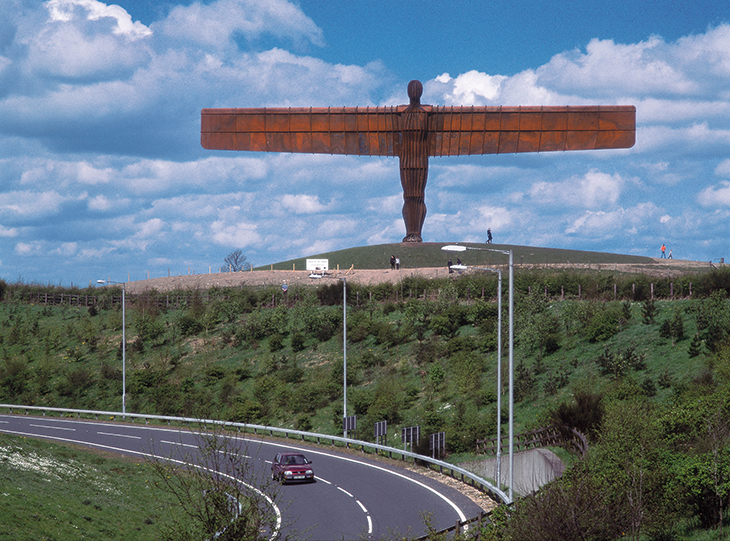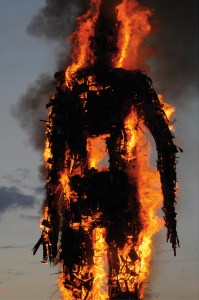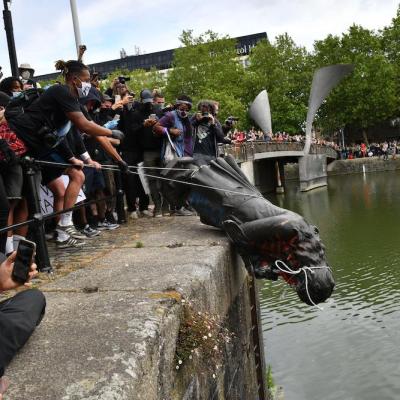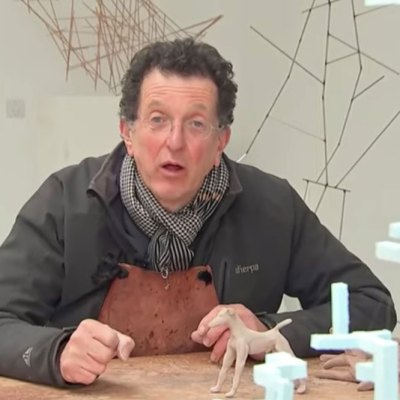From the April 2021 issue of Apollo. Preview and subscribe here.
These days there are few places quieter than the City of London. Recently, on a sunny February afternoon, I decided to take a bike ride through the financial district, making the most of the empty roads and cobbled back streets of this ghost town. At one point, I had to hit the brakes, startled to encounter another person standing at a junction where I was about to turn. Once I’d stopped, I realised it was not a human figure but a sculpture: Antony Gormley’s Resolution (2005). Up close (and if the sun is not in your eyes), the cast-iron sculpture – a shade over six feet tall – is quite clearly not an actual person but a tower of cuboid blocks, stacked to follow the contours of an upright body and vaguely reminiscent of the pixels that appear when you zoom in too close on an image on your phone or computer. Its hard-edged feet are fixed firmly to the ground, on the curb on the corner of Shoe Lane and St Bride Street.
There’s a chance I wouldn’t have even seen the sculpture, before the pandemic, amid the bustle of suits moving from office to Pret and back again. But also, there would have been so much else to see – so many shows that had just opened, or were just about to close, so many live performances and fairs and new displays in museums and galleries. Over the past year many of us (when not looking at a screen) will have spent more time outside, becoming more familiar with our local streets, buildings and the many different forms of artistic expression that might loosely be defined as ‘public art’, and of which Antony Gormley is perhaps the best-known living practitioner. (Gormley himself resists the phrase, which brackets off a particular kind of art as public, preferring to place the emphasis on the site of the work: ‘art in the public realm’, ‘art in collective space’, and so on.)
What better moment, then, to speak to a person who has – with his scattered crowd of bodies that dot the globe from cities to seashores, from the Austrian Alps to a salt lake in Western Australia – made a career out of the idea that art is not just something you find in a gallery, that in fact it might be all the more powerful when taken out of its usual context, and placed in the world at large?
Inside Australia (2003), Antony Gormley (pictured is one of 51 sculptures installed in Lake Ballard, Western Australia in 2003). Photo: Frances Andrijich, Perth; © the artist

And so, a few weeks after my encounter with Resolution, I find myself face to face with another pixelated Gormley. This time it is the artist himself, beamed into my kitchen via Zoom. No sooner has our conversation begun, with a question on what motivated him in the mid 1980s to begin placing his now-signature ‘bodyforms’ in outdoor locations, than the artist is offering a historicised argument on the essential function of sculpture. ‘The Enlightenment invented the picture gallery and the museum but prior to that, and actually still in many societies, the kinds of creative sharing that people do – and I would include gardening in this – are in a shared space, a collective space. The art they make is in the stories they tell, the dances they dance, the structures that they make collectively, and I think that is still the model, particularly for sculpture,’ Gormley says. ‘I have simply recognised the nature of my vocation, that it is of its nature collective and of its nature should exist in collective space.’
This expansive view of what art can be and where it can be found, with a particular emphasis on prehistoric and non-Western cultural production, is fundamental to Gormley’s approach. It can be traced back to his pre-art-school days: first, his undergraduate studies at Cambridge, where for a year he read archaeology and anthropology before switching to art history; and then the three years he spent travelling in India and Sri Lanka, training in Buddhist Vipassana meditation and, for a time, Chinese brush-drawing. By the mid ’70s he was back in London and undertaking a more conventional artistic education, studying at Saint Martin’s, Goldsmiths and the Slade, but he was already on a clear path. In his final-year written thesis at Goldsmiths, titled ‘The Stone’, he sought to establish humanity’s relationship to the material through millennia and across the world, from Mesolithic monuments in Ireland to Japanese rock gardens, and to the more recent experiments of land artists such as Richard Long. Today, among 20th-century touchstones, he cites the German artist Joseph Beuys, also a sculptor (as well as teacher, political activist, performer and self-described shaman), who similarly believed in the universality of the creative impulse across cultures and through time. ‘Beuys for me represents continuity, the idea that the new of itself has no intrinsic value or benefit, that modernity in some senses comes with a loss of history.’
Two Bodies (2000), Antony Gormley; © the artist

Over the course of his 40-year career, Gormley’s own art – his sculptures, which he sometimes describes as ‘totems’, but also his drawings, which for him constitute a kind of meditative daily practice – has both subtly and explicitly embodied this cross-cultural, transhistorical perspective. Take, as an uncommonly direct example, his aniline-dye drawings from around the turn of the millennium, such as Two Bodies, Alife and Against Time (all 2000). With their reddish washes and roughly drawn silhouetted figures, these small works seem like fragments of the very earliest paintings found in palaeolithic rock shelters – sites that Gormley has visited a few times (most recently courtesy of the BBC, for a documentary broadcast in 2019 called How Art Began).
Then there is his most famous work: the monumental Angel of the North (1998), which stands on top of a hill, gazing out over the A1 on the site of the pithead baths of the former Team Colliery in Gateshead, and which Gormley has referred to as ‘my Stonehenge’. Describing the ‘experiment’ that this winged steel behemoth represented to him, he says: ‘There’s no question that this is a pre-modern idea of what art can do. Here is a totem, a collectively engendered object that carries the materials and methods of the community and the place, the shipbuilding and the engineering, but uses it entirely imaginatively, in other words is non-functional, as a focus for a region’s hopes and fears.’
Angel of the North (1998), Antony Gormley; installed in Gateshead, Tyne and Wear. Photo: Sally Ann Norman

This sense of the Angel, as deeply rooted in its particular environment, goes some way to explaining the somewhat unusual move that Gormley recently took – and which was reported in the national press – of making multiple written submissions to Highways England objecting to planned upgrades to the A1 south of Gateshead which, he contended, would mar views of the sculpture. And he’s not alone – in March the Twentieth Century Society submitted an application to Historic England to list the Angel, describing it ‘as an icon not only of the North East, but of the UK as a whole’. The listing was rejected but the saga suggests that Gormley and his sculptures have become objects of public debate, discussed far more widely than almost any other contemporary artist or their output. See also the fact that, when a resident of the English seaside town of Aldeburgh installed a group of Gormley’s more abstract cast-iron sculptures on the beach earlier this year, complaints that they looked like ‘sex toys’ were eagerly reported in the newspapers. (In a further twist, the artist has objected to the owner of the works placing them on the beach when they are meant ‘to stand upright’.)
Quarters I (2005), Antony Gormley. Photo: Stephen White, London; © the artist

That is not to say that Gormley hasn’t had his fair share of conventional art-world action. From his first solo exhibition at the Whitechapel Gallery in 1981, and especially after his Turner Prize win in 1994, Gormley has never been short of important commissions and surveys – most recently an exhibition at the Royal Academy in London, which highlighted the somewhat overlooked range of Gormley’s work: his early casts of everyday items such as bread and apples (and, ironically enough, in a work titled Natural Selection [1981], a sex toy); his drawings; and more recent room-scale installations such as Clearing VII (2019), made up of tangled coils of aluminium tubing which the viewer is invited to walk through. There were plenty of bodies, too – ranging from rusty-red men cast from moulds of the artist’s own naked body, as in Lost Horizon I (2008), to his more abstracted figures built from cubes or bars of metal. The show closed just weeks before the first national lockdown of 2020. But during our conversation, some 12 months later, there is a sense that Gormley has found the past year clarifying in terms of what art can do – and why attitudes towards art (and where we see it) may now be changing.
‘It’s obvious that in a time when people can’t go to these specific locations where art is hospitalised, categorised, catalogued and conserved, that we are going to recognise that art can do a very, very different job,’ he says. ‘That the climate-controlled, light-controlled environments of museums actually take a lot of the potential dialogue of sculpture with time and place away.’ Yet the aesthetic experience of encountering art ‘in the elements’ is only one of what he calls the ‘silver linings’ of our current predicament. ‘We notice and care for our environment in a very different way – we’re not just passing through it; we’re dwelling in it.’ Gormley has been a committed advocate for climate action for many years and has repeatedly called for the art industry to reduce its carbon footprint. He has also spoken about the ways he hopes his own work – with its themes of body and place – might engender an increased awareness within individuals of our ‘connection to and dependence on the context in which we find ourselves’. He is currently working on a series of sculptures titled Cast Liners, begun in 2019 and made up of networks of thin cast-iron beams, which he describes as ‘diagnostic diagrams of being in the body’, ‘tangled things’ that express ‘how complex the intrarelationships of the biosphere are’.
Arrest (2019), Antony Gormley. Photo: Stephen White, London; © the artist

Gormley believes that, whether because of people’s increased connections to nature or out of straitened circumstances, there’s an opportunity to do things differently. ‘When I was growing up as an artist the only thing you had to aspire to was to be an international artist, that your work was going to go everywhere. I think in a time of climate emergency and in a time of Covid, well, that model just doesn’t work,’ he says. ‘The sheer amount of air miles that artworks and artists and collectors clock up in order to keep the machine going just has to be reckoned with.’ The alternative? ‘I can imagine many galleries and museums […] are all finding themselves with more space than they can economically use, and they’re going to have to offer that space, hopefully to artists, to local artist communities.’
Coursing through Gormley’s words is an almost religious conviction in the power of art and creativity as a vehicle for hope and healing (although he acknowledges that ‘I may be hopelessly utopian and romantic about this’). This year, alongside a virtual promotional tour for a new book co-written with the art critic Martin Gayford, Shaping the World: Sculpture from Prehistory to Now, he has been involved in a project called the Great Big Art Exhibition, which invites the locked-down British public to make art at home inspired by prompts from contemporary artists. Gormley was first up. His challenge? Make an animal sculpture out of a ball of clay. Gormley is brimming with praise for this and other similar initiatives, from the ‘Get Creative’ challenge instigated by Radio 4’s Front Row to Grayson’s Art Club on Channel 4. ‘The number of kitchen tables that have become mini studios for families working together,’ he says, ‘who then put something that they made inside the house out on the balcony, on the windowsill, in the window, and sharing it with their neighbours… This is a recovery, I think, of what I was going on about earlier – that creative sharing. I think we’ve found that again.’ Gormley’s own contribution to the Great Big Art Exhibition was a rather deftly handled miniature hound with a long muzzle and an alert stance – the same breed, possibly, that appears as an occasional motif in his studio work: see, for example, the series of Lost Dog sculptures made from forged ball bearings in 2002.
It would be remiss not to bring up the other side of the conversation that has gathered pace in the past year about the role of sculpture in the public sphere. What does Gormley make of the debate about historical statues and other monuments in the public sphere, which depict and memorialise figures from Western imperial history? ‘I think we have to recognise that statuary in particular has always been a form of power using art for its own purposes, of supporting its hierarchy,’ he says. ‘But I think it’s a very minor part of what art can do.’ He draws a somewhat counterintuitive equivalence between ‘the use of the Robert E. Lee equestrian statue by the far-right white supremacists in the States’ and ‘the dunking of Colston’s statue into the sea in Bristol’ by anti-racist protesters, suggesting that both are examples of ‘statue as materialised history, being somehow used as a trophy, as a rallying cry, or as a scapegoat’. He’s equally sceptical of a trend that can be identified within contemporary art, citing artists who produce counter-monuments to underrepresented figures and stories. ‘I think these are very post-modern tropes which fall into the trap of, in attempting to criticise the politics of the original work, actually reinforcing them and doing them again.’ This is why, perhaps, there are no plinths in Gormley’s sculpture – only bodies, rendered at various scales and to varying degrees of abstraction, but always without name or character, laying claim to no significance beyond the fact of their existence.
Waste Man (2006), Antony Gormley; installed in Margate in 2006. Photo: Thierry Bal; © the artist

For Gormley, all art is inherently political regardless of its content. ‘Certainly for me sculpture is a tacit act of hope because it says something like, “I don’t want to make a picture of the world, I want to change the world, I want to change the world by putting something that wasn’t there before in it, and the world then has to in some way accommodate this thing that often is a bit of an irritation or a confrontation”.’ This is not to suggest that all artworks are meant to last forever: ‘Well, I think if they are any good, they should become part of a place and if they’re not they’ll disappear.’ Some, it’s worth noting, are by their very nature ephemeral: in 2006, as part of a one-day arts festival in Margate, Gormley burnt to the ground a 25-metre-high sculpture titled Waste Man and built entirely from waste materials.
Above all, Gormley is dedicated to the idea of art as ultimately belonging not to its creator or its owner but to the public, the ‘collective’ realm where it is sited. He firmly believes that ‘you don’t need to know anything’ to experience his work – another reason, I think, that he has a greater audience for his work than most of his contemporaries. ‘You just need to go up to the thing, you can lick it if you like, but it would be good if you touched it, you should walk about it, you should think… well, there are no shoulds about it,’ he says. ‘I think that the meaning comes from what you make of it. Literally, what do you make of this thing with which you are sharing the world?’
From the April 2021 issue of Apollo. Preview and subscribe here.



